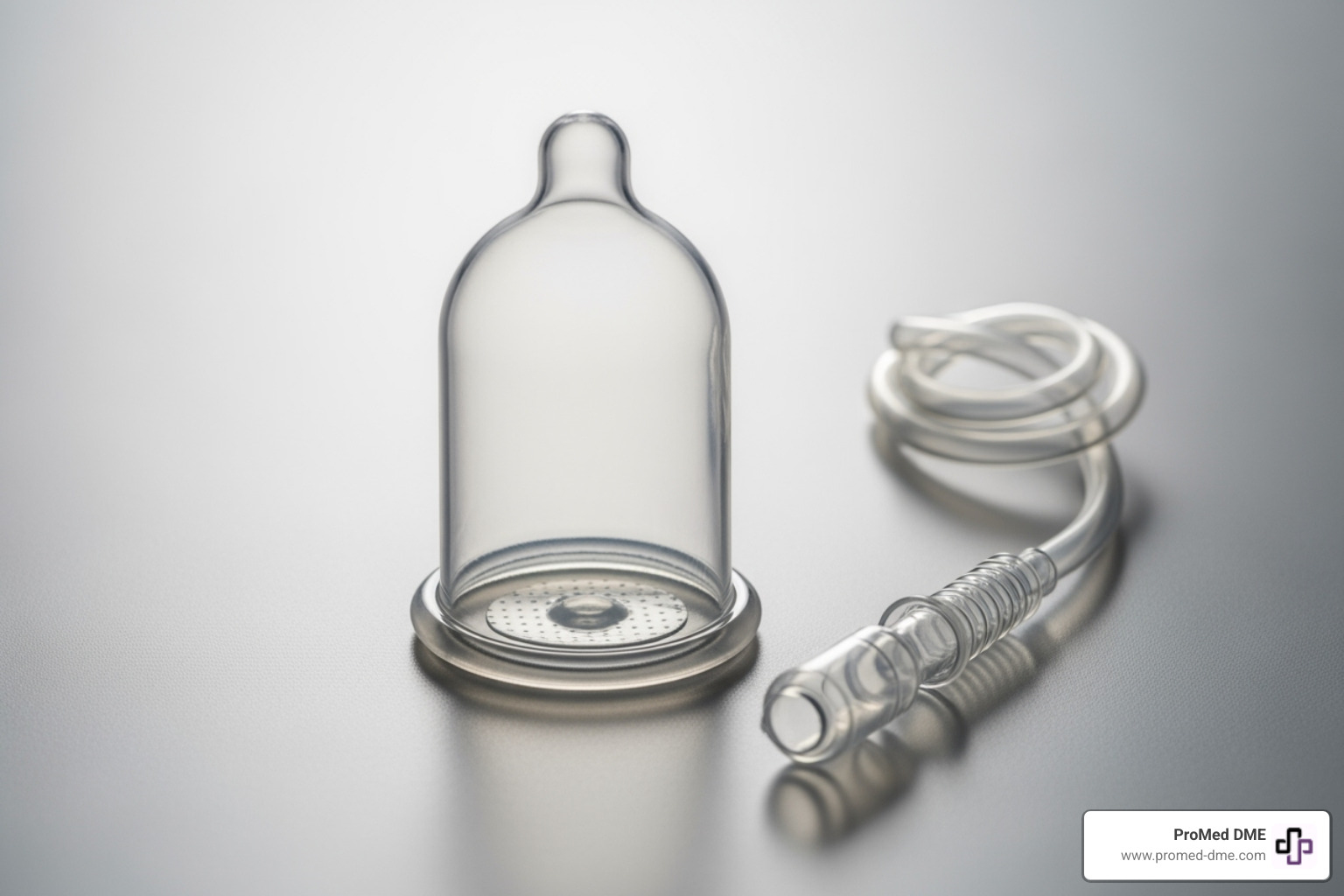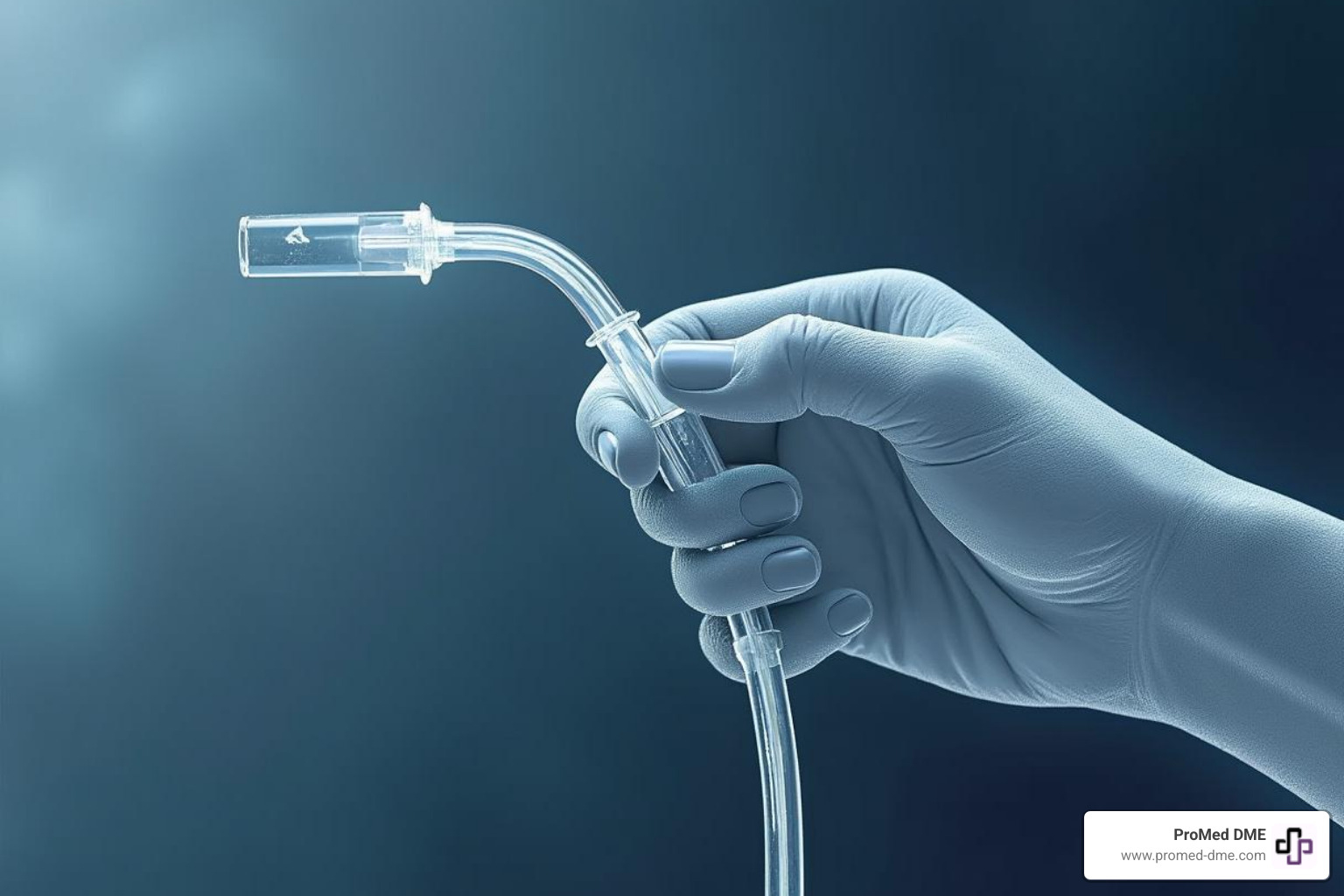Your Guide to Insulin Pump Infusion Sets: Comfort Meets Convenience
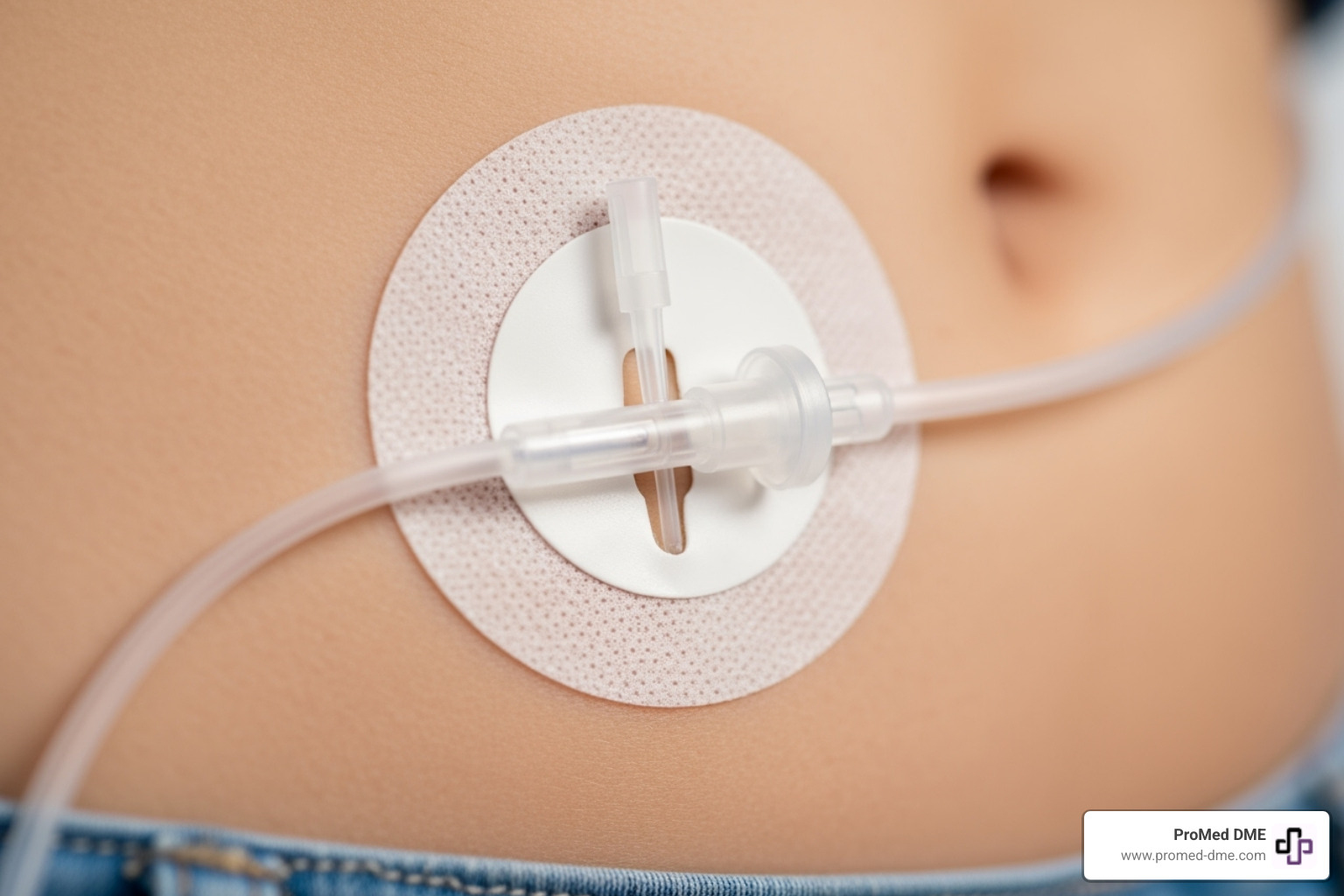
The Critical Link in Your Insulin Pump Therapy
Insulin pump infusion sets are the vital connection between your insulin pump and your body, delivering life-sustaining insulin through thin plastic tubing to a small cannula or needle placed under your skin. These medical devices consist of three main components: the tubing that carries insulin from your pump, the infusion site with either a soft plastic cannula or steel needle, and an adhesive patch that keeps everything securely in place.
Key facts about insulin pump infusion sets:
- Materials: Available with soft plastic cannulas or steel needles
- Change frequency: Every 2-3 days for most sets, up to 7 days for extended-wear options
- Insertion angles: 90-degree straight or 30-45 degree angled options
- Tubing lengths: Range from 18" to 43" depending on your lifestyle needs
- Compatibility: Must match your specific insulin pump brand and model
Whether you're new to pump therapy or looking to optimize your current setup, choosing the right infusion set can make a significant difference in your comfort and diabetes management success. As one diabetes educator noted, "It is important to be able to use at least 2 different infusion sets" to ensure you have options that work for different situations and body changes.
The right infusion set should match your body type, activity level, and personal preferences. Active individuals might prefer angled sets for flexibility, while those with dexterity challenges may benefit from all-in-one insertion devices. Understanding these options helps you work with your healthcare team to find the perfect fit.
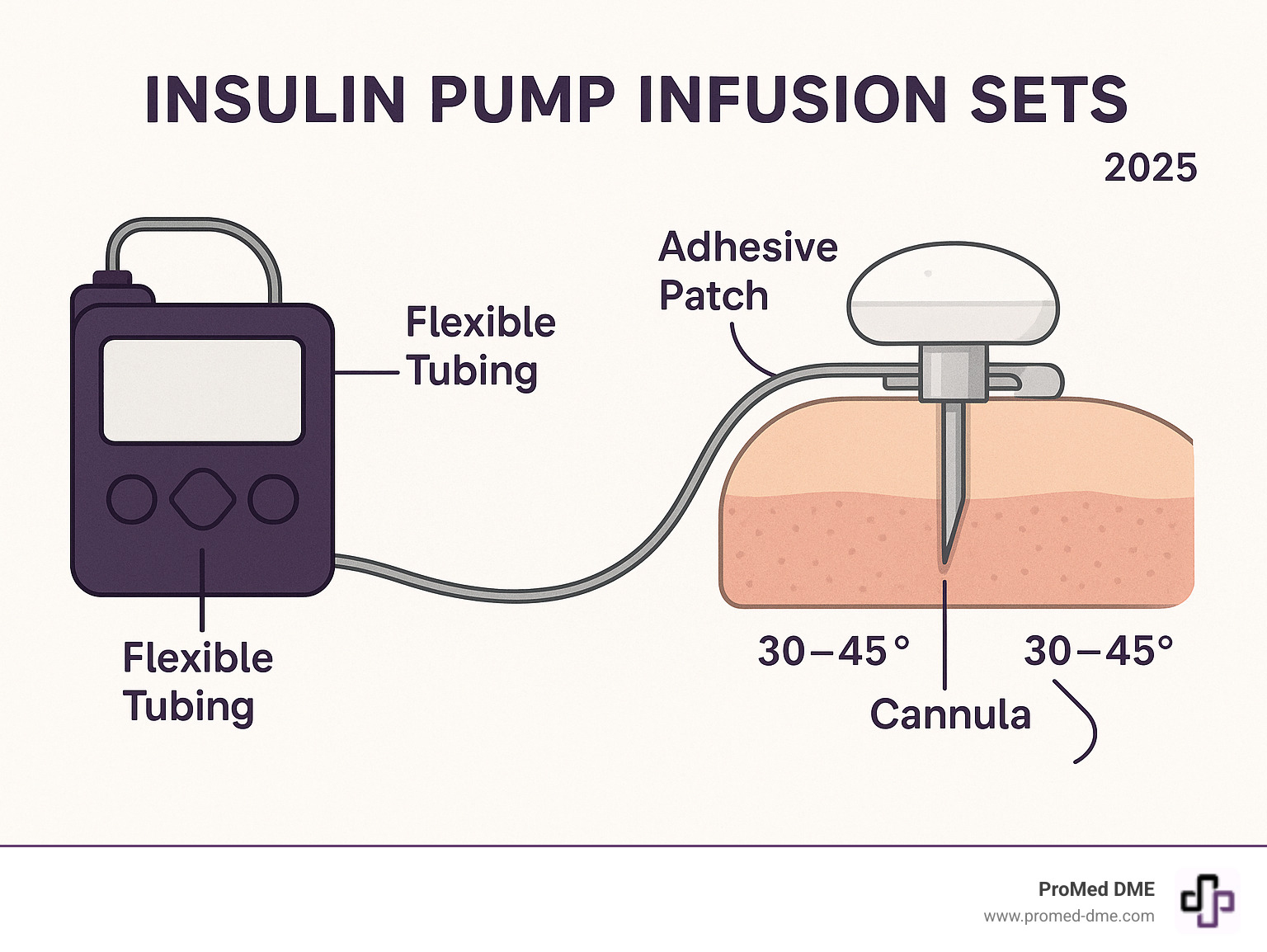
Insulin pump infusion sets helpful reading:
- how to use insulin pump therapy
- aace guidelines for insulin pump therapy
- advantages and disadvantages of insulin pump therapy
Decoding the Types of Insulin Pump Infusion Sets
Think of choosing insulin pump infusion sets like finding the perfect pair of jeans – what works beautifully for your friend might not be quite right for you. The good news is that understanding the key differences makes the selection process much simpler.
Every infusion set is essentially your insulin pump's lifeline to your body. It's made up of flexible tubing that carries insulin from your pump, a connector that links to your device, and an infusion site where either a tiny soft tube or a fine needle sits just under your skin. An adhesive patch keeps everything secure and comfortable. Most sets need changing every 2-3 days, though some newer options can stay put a bit longer.
The main characteristics that set different infusion sets apart are pretty straightforward: cannula material, insertion angle, tubing length, and the type of insertion device. Each of these features affects your comfort and how well your insulin gets delivered. If you'd like to dive deeper into the basics, What is an Infusion Set? offers some great additional insight.
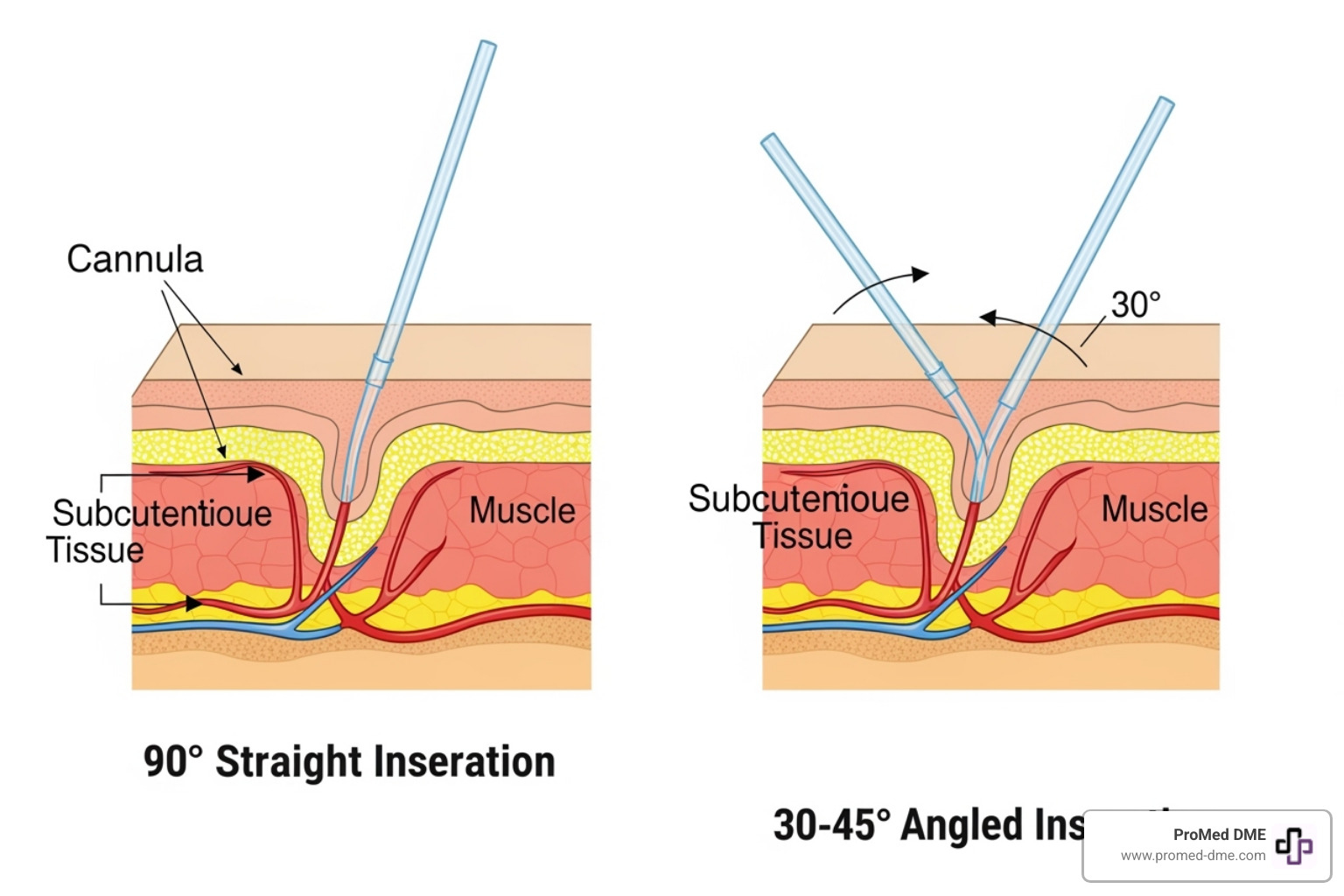
Soft Cannula vs. Steel Needle Sets
The biggest choice you'll make with insulin pump infusion sets is what actually goes under your skin. You've got two main options, and both have their loyal fans.
Soft cannula sets use flexible plastic cannulas (often made from Teflon) that bend and move with your body. Here's how they work: a sharp introducer needle guides the soft tube under your skin, then gets removed immediately, leaving only the flexible plastic behind. Most people find them incredibly comfortable – you can sleep, exercise, and go about your day without feeling them.
These sets should be changed every 2-3 days to keep your insulin absorbing properly. The main drawback? Bent cannulas can happen, especially if you're active or the cannula gets twisted during insertion. When this occurs, insulin flow stops, and your blood sugars can spike quickly.
Steel needle sets take a different approach entirely. A fine stainless steel needle stays under your skin to deliver insulin directly. Since there's no soft tube to bend or kink, these sets are essentially kink-proof. They're fantastic if you've dealt with bent cannulas before or have scar tissue that makes soft cannula insertion tricky.
Many people are surprised by how comfortable steel needles can be – some are as thin as 31 gauge, making insertion virtually painless. They do need changing every 2 days instead of 3, and they're often the go-to choice for pregnant women, infants, or anyone who needs that extra reliability. User preference really drives this decision – some people swear by the security of steel, while others love the flexibility of soft cannulas.
Angled vs. Straight Insertion Sets
The angle your infusion set goes into your skin might seem like a small detail, but it can make a big difference in your comfort and success with pump therapy.
90-degree insertion sets go straight down into your skin, perpendicular to the surface. They're generally the ease of use champions – most people find them simpler for self-insertion, especially if you have dexterity challenges or feel anxious about needle insertion. Many all-in-one insertion devices use this straight approach because it's so straightforward.
30-45 degree insertion sets take a more angled approach, sliding under your skin at a slant rather than straight down. This design is often perfect for people with lean body types or active lifestyles. The angled insertion gives you more flexibility in how deep the cannula sits and can be more comfortable if you don't have a lot of padding at your insertion sites.
If you're very active, muscular, or lean, angled sets often stay put better during exercise and daily movement. They also give you more options for where you can place them on your body, which is helpful for site rotation. The trade-off is that they can take a little more practice to insert confidently, but most people get the hang of it quickly.
How to Choose the Right Infusion Set for You
Finding the perfect insulin pump infusion set is like finding a great pair of jeans – it needs to fit your body, match your lifestyle, and make you feel comfortable all day long. There's no universal "best" choice because what works beautifully for your friend might not be right for you at all.
When we help customers at ProMed DME choose their infusion sets, we always start with the basics: What's your body type like? How active are you? Do you have any challenges with dexterity or needle anxiety? These aren't just casual questions – they're the key to finding an infusion set that will work seamlessly with your daily routine.
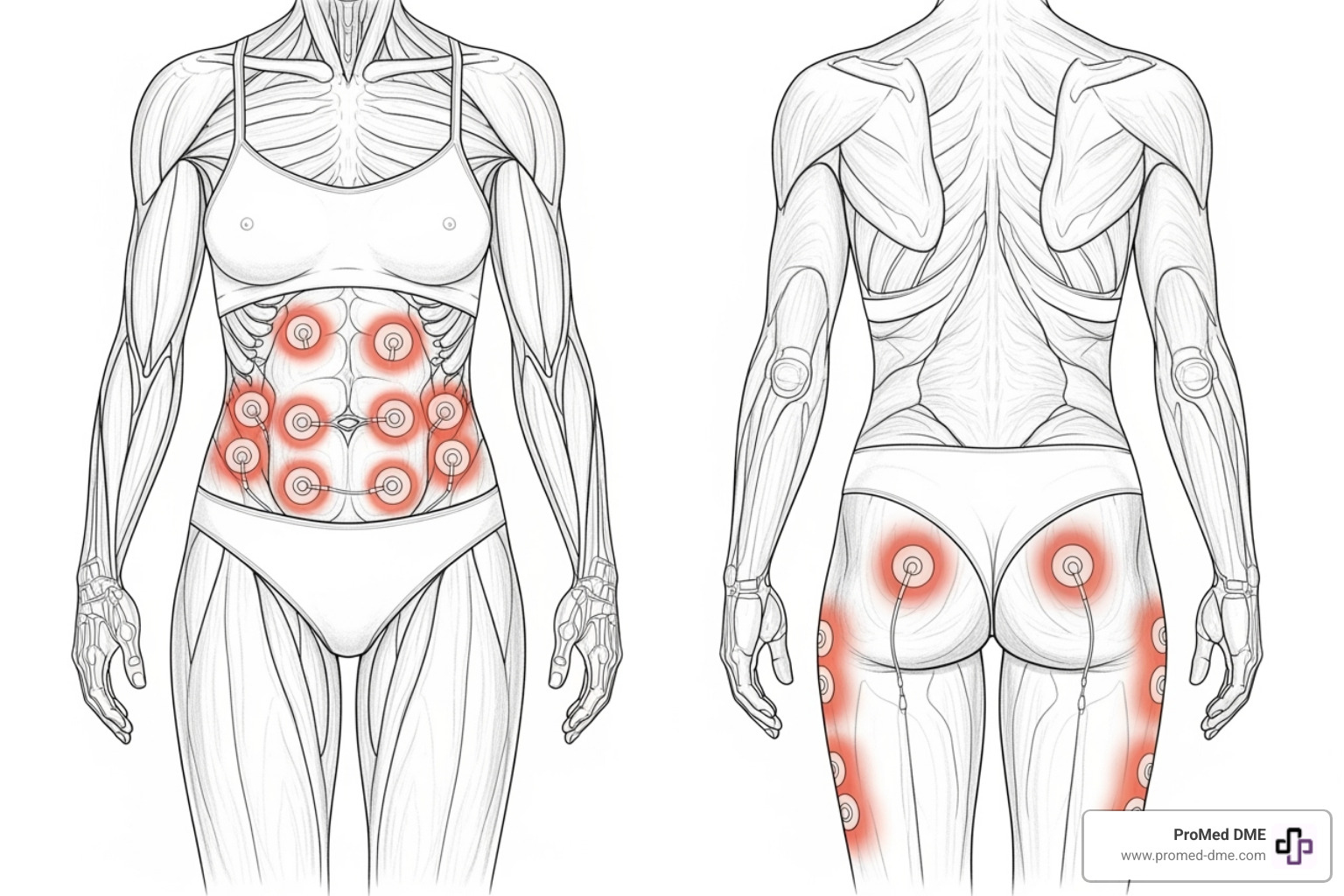
The location where you place your infusion set matters too. Most people use their abdomen, thighs, or buttocks, and rotating between these sites helps your skin heal properly while ensuring your insulin absorbs consistently.
Matching an Infusion Set to Your Body and Lifestyle
Your body tells a story, and the right insulin pump infusion sets should fit that story perfectly. If you're lean or have a muscular build, you might find that angled sets work better than straight ones. The angled insertion lets the cannula sit more comfortably in your subcutaneous tissue without going too deep or staying too shallow.
For our customers who are always on the move – whether that's chasing kids around, hitting the gym, or working a physically demanding job – we often recommend sets with extra security features. Angled sets tend to stay put better during activity, and some come with additional adhesive patches that keep everything secure even when you're sweating.
If you've been dealing with kinked cannulas or have some scar tissue from years of injections, steel needle sets might be your game-changer. They can't kink, and they're often easier to insert through tougher skin areas.
Now, let's talk about the elephant in the room – needle anxiety or dexterity challenges. If your hands shake a bit or the thought of insertion makes you nervous, all-in-one sets with built-in inserters are fantastic. You just press a button, and it's done before you know it. No fumbling with separate devices or staring at needles.
The Find and Compare Infusion Sets tool can help you narrow down your options based on what matters most to you. We always encourage our customers to explore their choices and have honest conversations with their diabetes team about what's working and what isn't.
Understanding Insertion Devices and Tubing Length
The way you insert your infusion set and how long your tubing is might seem like small details, but they can make or break your experience with insulin pump infusion sets.
Most modern sets come with some type of insertion helper. Some have simple spring-loaded devices that do the work for you with the push of a button. Others have everything built right into the set itself – you just press down, and the whole insertion happens automatically. These devices aren't just convenient; they also help ensure you get the same insertion depth and angle every time.
Tubing length is where personal preference really shines. Shorter tubing (around 18-23 inches) works great if you like keeping your pump close – maybe clipped to your bra, tucked in a shirt pocket, or in an armband. Less tubing means less chance of getting tangled up, and it keeps everything nice and discreet.
Longer tubing (32-43 inches) gives you freedom to roam. You can wear your pump on your belt, keep it in a pants pocket, or even tuck it into a bag. This extra length means you can move around without feeling like you're attached to a short leash.
The sweet spot is finding the combination that makes you forget you're even wearing a pump. That's when you know you've found your perfect match.
Best Practices for Infusion Set Use and Maintenance
Taking proper care of your insulin pump infusion sets isn't just about avoiding discomfort – it's about ensuring your insulin works effectively and keeping you healthy. Think of it like tending a garden; with the right care and attention, everything flourishes.
The golden rule of infusion set care is site rotation. Your body is remarkably adaptable, but it needs variety. Using the same spot repeatedly is like walking the same path through grass – eventually, you'll wear it down. When you keep inserting your set in the same location, your body responds by building up fatty tissue (called lipohypertrophy) and scar tissue. This doesn't just look bumpy under your clothes; it actually prevents your insulin from absorbing properly, making your blood sugar levels unpredictable.
We recommend thinking of your body in zones – your abdomen, thighs, and buttocks all make excellent insertion sites. Rotate between these areas and keep track of where you've been. Some people use a simple notebook, while others prefer smartphone apps. The key is staying organized so you're not guessing.
Preventing infection starts with a simple step that takes just seconds: cleaning your insertion site with an alcohol wipe before every set change. This isn't being overly cautious – it's being smart. Bacteria love warm, moist environments, and an insertion site can provide exactly that if not properly cleaned. After insertion, make sure your adhesive patch is firmly in place. A secure seal keeps bacteria out and your set exactly where it should be.
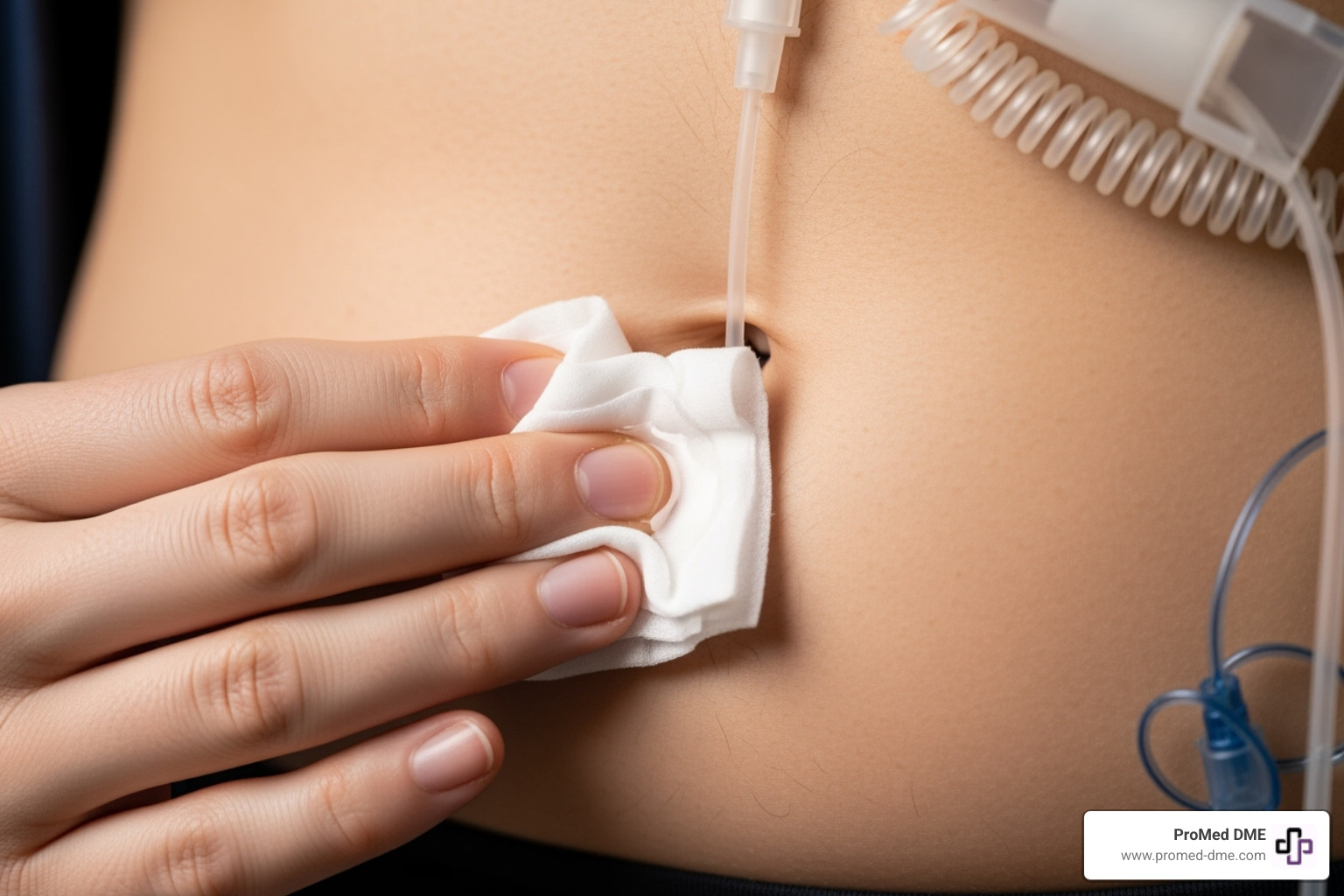
Your insulin absorption depends heavily on a clear path from your pump to your bloodstream. A kinked cannula is like a kinked garden hose – nothing gets through. This can lead to dangerously high blood sugar and even ketone formation. After inserting a new set, always check that everything looks smooth and straight. Your blood glucose monitor becomes your best friend here, helping you catch any delivery problems early.
How Often to Change Your Insulin Pump Infusion Sets
Timing your insulin pump infusion set changes isn't negotiable – it's essential for safe, effective insulin delivery. Your body treats any foreign object as something to wall off and protect against, which is exactly what happens if you leave a set in too long.
Plastic cannula sets should be changed every 2 to 3 days maximum. This isn't arbitrary timing; it's based on how your body responds to the cannula. After about 72 hours, your immune system starts building scar tissue around the insertion site. Meanwhile, your insulin begins losing its potency when exposed to body temperature for extended periods. Fresh sites mean better absorption and more predictable blood sugar control.
Steel needle sets need even more frequent attention, requiring changes every 48 hours. While steel needles don't have the kinking problems of soft cannulas, they can cause more tissue irritation over time. The trade-off for their reliability is more frequent changes.
The exciting news is extended wear sets, like certain advanced models, are now approved for up to 7 days of wear. These represent a significant breakthrough for people who prefer fewer site changes or have limited good insertion sites. However, longer wear doesn't mean less vigilance – you still need to monitor your blood sugar closely and watch for any signs of site problems.
These are maximum timeframes, not minimum requirements. If your blood sugar becomes unpredictable, your site looks irritated, or something just doesn't feel right, change your set immediately. Your body often knows before your mind does when something needs attention.
Preventing and Managing Common Infusion Set Issues
Even with perfect technique and timing, insulin pump infusion sets can occasionally cause problems. The good news is that most issues are predictable and manageable when you know what to watch for.
Kinked cannulas are the most common culprit behind mysterious high blood sugars. Picture trying to drink through a bent straw – nothing gets through. Prevention starts with choosing the right insertion angle and cannula length for your body type. If you're lean or muscular, angled sets often work better. Consistent use of insertion devices helps ensure proper placement every time. When your blood sugar spikes unexpectedly or your pump alarms for an occlusion, assume a kink and change your set immediately.
Occlusions block insulin flow completely, whether from kinked tubing, clots, or scar tissue. Modern pumps are pretty smart about detecting these problems, but your blood glucose meter is still your most reliable early warning system. Always prime your set completely before insertion to eliminate air bubbles, and make sure your insulin looks clear and particle-free. When an occlusion happens, change both your set and reservoir, then test your blood sugar frequently until levels stabilize.
Site irritation and infection show up as redness, swelling, pain, or unusual warmth around your insertion site. Prevention is straightforward: clean thoroughly before insertion, rotate sites religiously, and pay attention to how your skin reacts to different adhesives. Some people are sensitive to certain materials and need to try different brands. If you notice persistent irritation or any signs of infection, remove the set immediately and contact your healthcare provider.
Adhesive failure can be frustrating, especially during hot weather or physical activity. Your set might lose its stick or get accidentally pulled out. Keep your skin clean and completely dry before applying new sets, and consider skin prep wipes if you have trouble with adhesion. Some sets come with extra adhesive patches for people who need additional security.
Hyperglycemia and ketones can develop quickly when insulin delivery stops. Without insulin reaching your body, blood sugar rises rapidly and ketones can form – a potentially dangerous situation. Always carry backup insulin delivery methods like a pen or syringe, plus extra infusion sets. If you have unexplained high blood sugar, check for ketones immediately and change your entire set and reservoir as a precaution.
The key to managing these issues is staying prepared and responding quickly. Most problems resolve easily when caught early, but they can become serious if ignored.
Frequently Asked Questions about Infusion Sets
Over the years, we've helped countless customers at ProMed DME find the perfect insulin pump infusion sets for their needs. Along the way, we've noticed that many people have similar questions when they're first exploring their options or considering a switch. Let me share some of the most common questions we hear, along with answers that I hope will help you feel more confident about your choices.
What's the main difference between a soft cannula and a steel needle?
This is probably the question we get asked most often, and it's a great place to start! The difference really comes down to what stays under your skin after insertion.
With a soft cannula set, you get the best of both worlds for comfort. A sharp introducer needle helps guide a flexible plastic tube (the cannula) under your skin, then the needle is immediately removed, leaving only the soft, bendy plastic behind. Think of it like a tiny, flexible straw that moves with your body. This makes them incredibly comfortable during exercise, sleep, or just daily activities. Most people change these every 2-3 days.
The downside? Sometimes that flexible plastic can kink or bend, which blocks your insulin delivery and can lead to unexpectedly high blood sugars.
Steel needle sets work differently. A fine, thin metal needle stays under your skin to deliver your insulin directly. I know it sounds scarier, but many of our customers are surprised by how comfortable they actually are! The big advantage is that metal doesn't kink, so you get reliable insulin delivery every time. They're especially helpful if you've had problems with bent cannulas or have areas of scar tissue where soft sets struggle to work properly. These are typically changed every 2 days.
How do I know what tubing length I need?
This question always makes me smile because the answer is so personal - it really depends on how you like to wear your pump and live your life.
Shorter tubing (usually 18 to 23 inches) works beautifully if you prefer keeping your pump close to your infusion site. Maybe you clip it to your bra, tuck it in a shirt pocket, or wear it in an armband while exercising. Less tubing means less chance of getting tangled up, and it can be more discreet under fitted clothing.
Longer tubing (typically 32 to 43 inches) gives you much more freedom to move around. You can clip your pump to your waistband, keep it in a pants pocket, or even carry it in a small bag or backpack. This extra length is fantastic if you're very active or just like having your pump further away from your infusion site.
Here's my practical advice: think about your typical day. Where do you usually keep your phone or keys? That's probably a good indicator of where you'd be comfortable wearing your pump, and that will help you choose the right tubing length.
Are all insulin pump infusion sets compatible with every pump?
Unfortunately, no - and this is really important to get right! Insulin pump infusion sets aren't universal, which can be frustrating when you're trying to find the perfect set for your needs.
Each pump brand has specific connectors that the infusion sets must match. Some use standard connections, while others have their own unique designs that only work with their pumps. It's a bit like trying to use the wrong charger for your phone - it simply won't work properly.
Using an incompatible set isn't just inconvenient; it can be dangerous. You might not get proper insulin delivery, your pump could malfunction, or you could even void your warranty. Always double-check that any infusion set is specifically approved for your exact pump model before using it.
If you're ever unsure about compatibility, don't hesitate to reach out to us at ProMed DME. We're here to help you find the right insulin pump infusion sets that work safely with your specific pump, and our dedicated nurse is always available to answer questions about your diabetes supplies.
Conclusion: Taking the Next Step in Your Pump Journey
Choosing the right insulin pump infusion sets doesn't have to feel like solving a complex puzzle. While there are many options – soft cannulas versus steel needles, angled versus straight insertions, different tubing lengths – each one exists for a good reason. They're designed to work with different body types, activity levels, and personal preferences, all with one goal in mind: helping you manage your diabetes comfortably and effectively.
Think of it like finding the perfect pair of jeans. What works wonderfully for your friend might not be quite right for you, and that's completely normal. The key is understanding what matters most for your lifestyle and working with your healthcare team to find your perfect match.
Your informed choice about infusion sets is really about taking control of your diabetes management in a way that fits seamlessly into your life. Maybe you're an athlete who needs the flexibility of angled sets, or perhaps you have dexterity challenges that make all-in-one insertion devices a game-changer. Whatever your situation, there's likely an infusion set designed with you in mind.
You don't have to figure this out alone. Your healthcare provider – whether that's your endocrinologist, diabetes educator, or pump trainer – has seen it all and can offer invaluable guidance. They can help you try different options, check your insertion sites, and troubleshoot any issues that come up. Don't hesitate to speak up about what's working and what isn't.
At ProMed DME, we've been helping people across the United States access the diabetes supplies they need from our home base in Stuart, Florida. We know that having the right insulin pump infusion sets delivered reliably to your door makes a real difference in your daily life. That's why we work with most insurance plans to keep your costs down, offer free shipping, and have a dedicated nurse on staff to answer your questions.
Whether you're just starting your pump journey or looking to optimize your current setup, we're here to support you every step of the way. Your comfort and convenience matter, and finding the right supplies shouldn't add stress to your life.
Ready to explore your options or need assistance with your diabetes supplies? Let us help you take the next step.
Related Resources & Articles
Stay informed with our informative blog posts.
Discover the ProMed Advantage
& Try Our Products
We offer free shipping and legendary customer service to ensure you receive the
best DME products for your needs.

